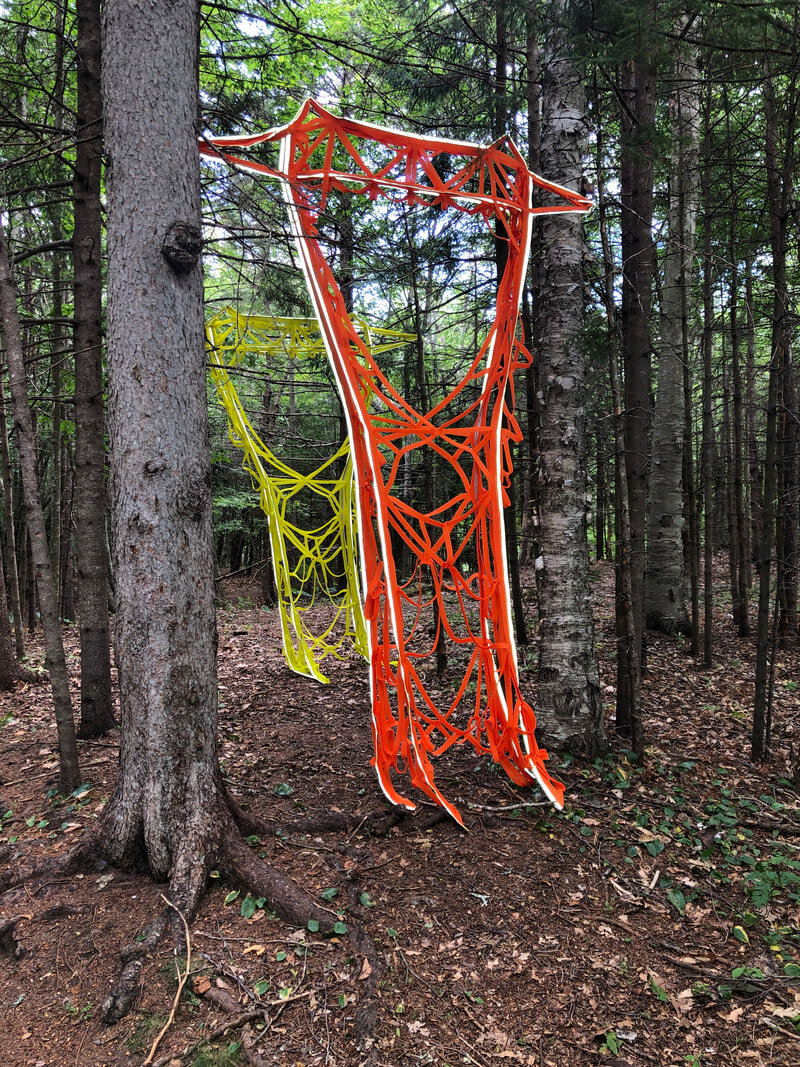published in visual arts news
There is a fundamental role that buildings and fabricated structures play in our daily lives, in the way that they demarcate ownership of spaces and invite specific use or actions through their functional design, or lack thereof. Curious about the ways in which we can imagine space for alternative means, and dive into fraught histories of urban design, I spoke with Melanie Colosimo and Angela Henderson. Both artists work closely with ideas of how humans intervene in the physical world, each offers their own formal and conceptual interpretations of intersecting and common themes surrounding bodies in space.
Henderson examines how we exist in relation to the physical world; through mapping as a form of social practice, examining overlooked urban environments, how communities leave traces of memory through building and even by using her own body as a parameter for sculptural forms. Colosimo defines her practice as an examination of what joins and divides communities, looking to built structures as metaphors of barriers and transition – drawing on her own relationships to nostalgia, dislocation and longing. We sat down to talk about how architecture finds its way into their respective practices; a lively three-way conversation of our upbringings, lives as women working in contemporary arts institutions, and our celebratory and questioning interests in human imposition on the world.
Sally Wolchyn-Raab:
To start our conversation off, could you each speak briefly about how architecture plays a role in your practice?
Angela Henderson:
My background is in design and architecture, I've come to an art practice from a professional background with a feminist perspective. My work has been less about the buildings and the bricks and mortar and more of what emerges between those spaces. More specifically the way that people and non-human life take up those spaces and how they can be seen as spaces of potential.
Melanie Colosimo:
I see architecture as an influence but not the main idea of my practice. I'm interested in how places bring people together but also can keep people apart. How they build community and create barriers. I use objects like scaffolding and fencing as transitory elements that have a temporary function.
Wolchyn-Raab:
Both of you talk about architectural structures as vehicles of liminality. Can you each talk about where your interests in liminality come from, and how it plays into your work?
Henderson:
I think of the idea of betweenness comes from my own personal experience of being in my mid-20’s and having an emptiness of not really understanding what my existence is outside of the religious and social context that I grew up in. That’s transformed into looking at in-between and negative spaces for their social potential.
Colosimo:
I have a very similar experience! I was brought up in the Pentecostal church. While they did a lot of positive work for the community, there is also a very insular and limiting nature to that kind of upbringing. I feel like I deal with the process of parting with the community all of the time. My interest in liminality came from the really impactful experience of entering art school for the first time, and feeling a personal transition away from my home community.
Wolchyn-Raab:
It seems like the notions of transitory space and structures blends social issues with psychological and emotional transformation for both of you.
Colosimo:
The drawings of fences are about gender identity and what kinds of experiences I’ve had as a woman working University Galleries. Process is also very important to me; the first fence drawing I made was on a 300-inch roll of paper. The process of drawing and then rolling the finished areas up again forced the drawing to transform. In the end what started as a tight and realistic drawing of a fence dissolved into this wavy structure with broken links, it was like a personal journey that I had been on through undertaking a meditative drawing process.
The last one that I've done is actually a fence made of penises on a nine-foot piece of paper. My work draws from my experiences of trying to be taken seriously in a profession that has historically been male dominated. I take into consideration the proportion of the body to the paper and the proportions of the body to the subject matter. I’ve cut away the first row so that it curls away and is very flaccid, process allows me to rob these structures of their power.
Henderson:
I was in Poland this summer with a group of artists who were working with holocaust mass grave sites in the forests. I was there exploring embodied and emotional mapping. During this project I determined that there were very old trees on all of these sites, and used the idea of those trees as witnesses. The locations of mass graves can only be estimated because they can’t dig into them, so I was demarcating the perimeter of the site with string – looking at the artistic as another strata of understanding.
I see mapping as kind of opposition to cartography. The discipline of cartography can be very patriarchal and capitalistic, it’s based on principles of dividing land for primarily economic purposes. But in mapping there's more room to define your own parameters because maps are always an abstraction. Mapping is a way of like locating us in relation to something else, physical or ideological. There’s more flexibility than cartography, so it’s a kind of counter to that way of thinking.
Wolchyn-Raab:
It seems like both of you are working with the assertions of how manmade structures impress upon the natural world. When we’re talking about capitalist structures, you’re also talking about patriarchy because we can't peel the two apart.
Colosim:
At the Banff Centre and everyone there makes some kind of work about the mountains, you can’t not. I was thinking about how the landscape of Atlantic Canada plays into my drawings, how important the horizon is, and how it’s obscured by the mountains there. The Rocky Mountains are a natural barrier that felt claustrophobic to me, but they’re also the reason that the community at Banff exists. I go back to my basic statement of my work: what brings people together and what keeps people apart?
Henderson:
I'm really interested in the St. Patrick’s School – how it’s breaking down and its materials are reclaimed by time. There’s a relationship between built structures and our bodies. I’m always thinking about space in relational measure to my body, I use my body as a way of bracketing and giving my work some parameters. When we look at space through planning and architecture, it has a very specific analysis determined to undervalue because it’s purely economic. In terms of the St. Patrick’s school, it’s not used by these designs. It’s being used in a way beyond its original intent by the public and by the natural vegetal and animal life. So, I think these spaces have a lot to offer us but we need a way of looking at them that isn’t purely capitalistic.
Wolchyn-Raab:
Is there anything that you think architecture as a field can learn from contemporary art?
Henderson:
I question the fetishization of modernism in architecture, the unapologetic use of modern structures and language in building is really irresponsible in the time that we live in. I also think the one percent rule [where new development requires one percent of the budget to be used for public art] could be an excellent means of intervention. Imagine if those funds were used to create artistic platforms rather than a single, static sculpture.
Colosimo:
I’ve gotten to consult on public art before for new developments and find there’s always a fetishization of the Atlantic Nova Scotian aesthetic, and a lack of consideration for representing more than a narrow demographic of artists – usually these kinds of international white male artists.

